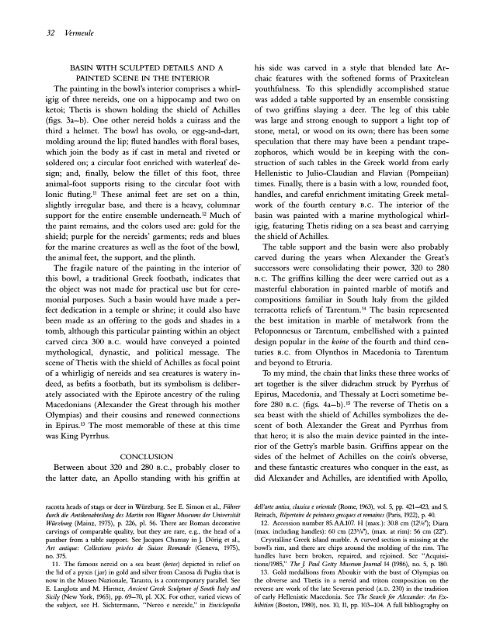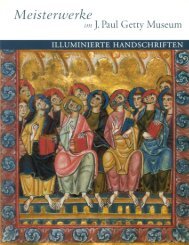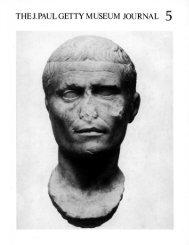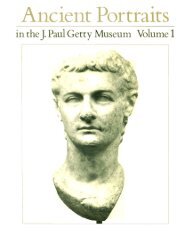The J. Paul Getty Museum Journal Volume 15 1987
The J. Paul Getty Museum Journal Volume 15 1987
The J. Paul Getty Museum Journal Volume 15 1987
Create successful ePaper yourself
Turn your PDF publications into a flip-book with our unique Google optimized e-Paper software.
32 VermeuleBASIN WITH SCULPTED DETAILS AND APAINTED SCENE IN THE INTERIOR<strong>The</strong> painting in the bowl's interior comprises a whirligigof three nereids, one on a hippocamp and two onketoi; <strong>The</strong>tis is shown holding the shield of Achilles(figs. 3a—b). One other nereid holds a cuirass and thethird a helmet. <strong>The</strong> bowl has ovolo, or egg-and-dart,molding around the lip; fluted handles with floral bases,which join the body as if cast in metal and riveted orsoldered on; a circular foot enriched with waterleaf design;and, finally, below the fillet of this foot, threeanimal-foot supports rising to the circular foot withIonic fluting. 11 <strong>The</strong>se animal feet are set on a thin,slightly irregular base, and there is a heavy, columnarsupport for the entire ensemble underneath. 12Much ofthe paint remains, and the colors used are: gold for theshield; purple for the nereids' garments; reds and bluesfor the marine creatures as well as the foot of the bowl,the animal feet, the support, and the plinth.<strong>The</strong> fragile nature of the painting in the interior ofthis bowl, a traditional Greek footbath, indicates thatthe object was not made for practical use but for ceremonialpurposes. Such a basin would have made a perfectdedication in a temple or shrine; it could also havebeen made as an offering to the gods and shades in atomb, although this particular painting within an objectcarved circa 300 B.C. would have conveyed a pointedmythological, dynastic, and political message. <strong>The</strong>scene of <strong>The</strong>tis with the shield of Achilles as focal pointof a whirligig of nereids and sea creatures is watery indeed,as befits a footbath, but its symbolism is deliberatelyassociated with the Epirote ancestry of the rulingMacedonians (Alexander the Great through his motherOlympias) and their cousins and renewed connectionsin Epirus. 13<strong>The</strong> most memorable of these at this timewas King Pyrrhus.CONCLUSIONBetween about 320 and 280 B.C., probably closer tothe latter date, an Apollo standing with his griffin athis side was carved in a style that blended late Archaicfeatures with the softened forms of Praxiteleanyouthfulness. To this splendidly accomplished statuewas added a table supported by an ensemble consistingof two griffins slaying a deer. <strong>The</strong> leg of this tablewas large and strong enough to support a light top ofstone, metal, or wood on its own; there has been somespeculation that there may have been a pendant trapezophoros,which would be in keeping with the constructionof such tables in the Greek world from earlyHellenistic to Julio-Claudian and Flavian (Pompeiian)times. Finally, there is a basin with a low, rounded foot,handles, and careful enrichment imitating Greek metalworkof the fourth century B.C. <strong>The</strong> interior of thebasin was painted with a marine mythological whirligig,featuring <strong>The</strong>tis riding on a sea beast and carryingthe shield of Achilles.<strong>The</strong> table support and the basin were also probablycarved during the years when Alexander the Great'ssuccessors were consolidating their power, 320 to 280B.C. <strong>The</strong> griffins killing the deer were carried out as amasterful elaboration in painted marble of motifs andcompositions familiar in South Italy from the gildedterracotta reliefs of Tarentum. 14<strong>The</strong> basin representedthe best imitation in marble of metalwork from thePeloponnesus or Tarentum, embellished with a painteddesign popular in the koine of the fourth and third centuriesB.C. from Olynthos in Macedonia to Tarentumand beyond to Etruria.To my mind, the chain that links these three works ofart together is the silver didrachm struck by Pyrrhus ofEpirus, Macedonia, and <strong>The</strong>ssaly at Locri sometime before280 B.C. (figs. 4a—b). <strong>15</strong><strong>The</strong> reverse of <strong>The</strong>tis on asea beast with the shield of Achilles symbolizes the descentof both Alexander the Great and Pyrrhus fromthat hero; it is also the main device painted in the interiorof the <strong>Getty</strong>'s marble basin. Griffins appear on thesides of the helmet of Achilles on the coin's obverse,and these fantastic creatures who conquer in the east, asdid Alexander and Achilles, are identified with Apollo,racotta heads of stags or deer in Würzburg. See E. Simon et al., Führerdurch die Antikenabteilung des Martin von Wagner <strong>Museum</strong>s der UniversitätWürzburg (Mainz, 1975), p. 226, pi. 56. <strong>The</strong>re are Roman decorativecarvings of comparable quality, but they are rare, e.g., the head of apanther from a table support. See Jacques Chamay in J. Dörig et al.,Art antique: Collections privees de Suisse Romande (Geneva, 1975),no. 375.11. <strong>The</strong> famous nereid on a sea beast (ketos) depicted in relief onthe lid of a pyxis (jar) in gold and silver from Canosa di Puglia that isnow in the Museo Nazionale, Taranto, is a contemporary parallel. SeeE. Langlotz and M. Hirmer, Ancient Greek Sculpture of South Italy andSicily (New York, 1965), pp. 69-70, pi. XX. For other, varied views ofthe subject, see H. Sichtermann, "Nereo e nereide," in EnciclopediadelVarte antica, classica e Orientale (Rome, 1963), vol. 5, pp. 421—423, and S.Reinach, Repertoire de peintures grecques et romaines (Paris, 1922), p. 40.12. Accession number 85.AA.107. H (max.): 30.8 cm (12V8"); Diam(max. including handles): 60 cm (23 5 /s"), (max. at rim): 56 cm (22").Crystalline Greek island marble. A curved section is missing at thebowl's rim, and there are chips around the molding of the rim. <strong>The</strong>handles have been broken, repaired, and rejoined. See "Acquisitions/1985,"<strong>The</strong> J. <strong>Paul</strong> <strong>Getty</strong> <strong>Museum</strong> <strong>Journal</strong> 14 (1986), no. 5, p. 180.13. Gold medallions from Aboukir with the bust of Olympias onthe obverse and <strong>The</strong>tis in a nereid and triton composition on thereverse are work of the late Severan period (A.D. 230) in the traditionof early Hellenistic Macedonia. See <strong>The</strong> Search for Alexander: An Exhibition(Boston, 1980), nos. 10, 11, pp. 103-104. A full bibliography on








